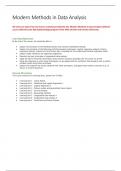Summary
Summary for Modern Methods in Data Analysis
- Course
- Institution
An overview/summary of the course 'Modern Methods in Data Analysis' (part of Epidemiology at Utrecht University/UMC Utrecht). Linear Models, Likelihood and Logistic Regression are explained. Also Poisson models and generalized linear models, Survival Analysis, Resampling methods, Longitudinal Dat...
[Show more]



